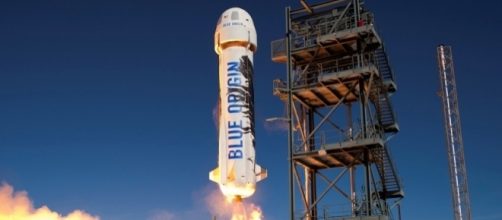In recent days there has been news in the scientific community in three varied areas. First, Blue Origin, a privately funded spaceflight services and aerospace manufacturer has reusable rockets. Blue Origin was set-up by billionaire and CEO of Amazon Jeff Bezos. There was also a new discovery scientists have made on everyone's favorite gas giant Jupiter and scientists in Japan want to drill all the way to the Earth's mantle.
Blue Origin's reusable rockets
At last week's 33rd annual Space Symposium in Colorado Springs, Blue Origin said that their lunar delivery program Blue Moon would use technology that the company has spent years working on as part of their New Shepard reusable rocket system.
The New Shepard reusable rockets have not yet been tested with customer payloads, which is important since the Blue Moon program could carry as much as 10,000 pounds of material from Earth to the Moon. If successful the cost of space travel would be lowered and the same rockets could be used to go to and come back from the Moon, which would make potential colonization much easier.
Jupiter discovery
Another day and more new news to announce about one of the planets in our solar system. A British-led team, headed by lead author Tom Stallard from the University of Leicester, released their new study on Jupiter. By using a telescope in Chile, the team was able to chart the density and temperature of the largest planet in the solar system.
However, the new discovery was not made until these new findings got compared with images taken over the past few years with a telescope in Hawaii. It was then that "The Great Cold Spot" on Jupiter stood out.
The "Great Cold Spot" is in the upper atmosphere of Jupiter, and is much cooler than its surroundings and the energy from the planet's polar auroras forms it. This weather system is constantly changing size and shape, but scientists reported that it is a massive 7,500 miles wide and 15,000 miles across.
Wanting to drill to the mantle
An international team of researchers led by Japan's Agency for Marine-Earth Science and Technology (JAMSTEC) plan on using the "Chikyu," which is JAMSTEC's largest drilling ship, to try to drill into the mantle of the Earth for the first time.
The team will run a preliminary study off of Hawaii's waters to see if that would be the ideal place to drill, with backup areas being off of Costa Rica and Mexico. To get to the mantle, the ship's drill would have to go through 2.5 miles of water and 3.7 miles of the Earth's crust.
Researchers hope that this will also help to answer how the crust got formed and if microbial life is alive that deep inside the Earth. The project does need $542 million in funding even once the perfect drilling spot is found, with the hope that excavation can start in the early 2020s, with 2030 being the latest set start date.

